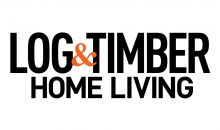Basics: What is Timber Framing?
What is timber framing?
Timber framing is a distinctive style of building construction in which heavy timbers frame the structure instead of more slender dimensional lumber (for example, 2 x 6-in.). Timber framing was a building practice used throughout the world until toughly 1900 when the demand for cheap, fast housing brought dimensional lumber to the construction forefront. In the 1970s, craftsman revived the timber framing tradition in the United States and have ushered the design style into the modern era.
One of the most defining elements of a timber frame is its unique joinery. Heavy timber is joined together via mortises and tenons, then secured with wooden pegs.
What are the differences among dimensionally built, log homes, post and beam, and timber framing?
Dimensionally built structures (sometimes called stick built) are framed with slender dimensional lumber—lumber in preset sizes that is readily available at lumberyards.
Log homes and structures are built of logs stacked horizontally, forming the walls.
In post and beam structures, upright posts support horizontal beams. These may be built of logs (round) or timber (milled to square). Post and beam structures are sometimes made of timber that is held together by metal brackets.
Timber framing is a specialized version of timber post and beam that is built like furniture, using wood joinery such as mortise and tenon, held in place with wooden pegs.
As designs become more intricate and code requirements more stringent, the distinction between some of these common terms becomes blurred. For example, timber frames may require engineered connectors in some joints. These connectors can be hidden inside the joint instead of attached to the timber surface, preserving the traditional timber frame appearance while making use of non-traditional technologies. Also, hybrid structures are prevalent, where timber framing and stick building are each used in the construction of different parts of a building.
Where in the world is timber framing practiced now?
Today, there are active timber framing communities in Australia, Canada, Denmark, France, Germany, United Kingdom, United States, and Japan. People from several other countries continue timber framing as individuals. Apprenticeship programs exist in France, Germany, United Kingdom, and the United States.
What is a raising?
In timber framing, all of the structural timbers for a building are prepared ahead of time—sized, planed, and joinery cut, all according to shop drawings. The elements of each cross-section, or bent, are test-fitted; then, when all cutting and testing is done, the bents are assembled and raised from horizontal to vertical one by one. As each bent is raised, it is joined onto the bent(s) already erect by horizontal beams. Then, usually, roof timbers are placed on top of the frame.
This raising can take place by hand—a hand raising—for smaller or historically authentic frames, through the use of pike poles, ropes, and people power. Gin poles and A-frames can help raise a frame. Or cranes can lift bents and timbers into place. Some raisings use a mix of methods.
What is joinery?
Joinery is what ties timbers together, in traditional timber framing. The ends of timbers are carved out so that they fit together like puzzle pieces. A hole about an inch in diameter is drilled right through the joint, and a wooden peg is pounded in to hold the joint together.
The universe of possible joints is quite large and complex. Common joints include mortise and tenon, dovetail, tying joint, scarf joint, and lap joint. There are many variations and combinations of these and other types of joinery.
What is a SIP?
A SIP is a structural insulated panel. SIPs can surround an entire timber frame, leaving all the majestic timber visible in the interior and providing an airtight barrier. A SIP is composed of an insulating foam core (expanded polystyrene or extruded polystyrene) sandwiched between two structural facings, typically oriented strand board. The result is a building system that is extremely strong, energy efficient, and cost-effective.
What is a built-up infill wall?
Some builders create their own infill. A typical built-up infill system relies on a groove or channel cut into all faces of the timber in which the plane of the wall lies. On the inside face of the inserted cement board or plywood panel, light framing is installed to receive either wood, cement board, or gypsum wallboard for the interior finish of the building. Lathe and plaster may all be applied to the light framing.
Insulation may consist of a hard foam board applied either externally to the plywood panel, or internally between the cement board and light framing.
Generally, the spaces in between the light framing are also insulated, either with a spray insulation, cellulose, or fiber insulation.
Click on a photo to enlarge.









